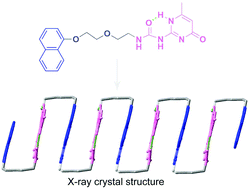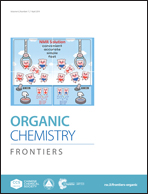Biomimetic folding of small organic molecules driven by multiple non-covalent interactions†
Abstract
Here we report our research on biomimetic folding architectures self-assembled hierarchically from well-designed UPy-based monomers with low molecular weight (MW < 400 Da). These monomers are first dimerized via quadruple hydrogen bonding and then form folded dimers with the assistance of π–π interactions. More interestingly, the folded dimer further formed one-dimensional supramolecular stacks through additional weak π–π interactions in the solid state. Similar to DNA, these well-defined structures are stabilized by the concerted hydrogen bonding and π–π interaction in a synergistic manner, which would provide inspiration for constructing biomimetic self-folding materials.



 Please wait while we load your content...
Please wait while we load your content...